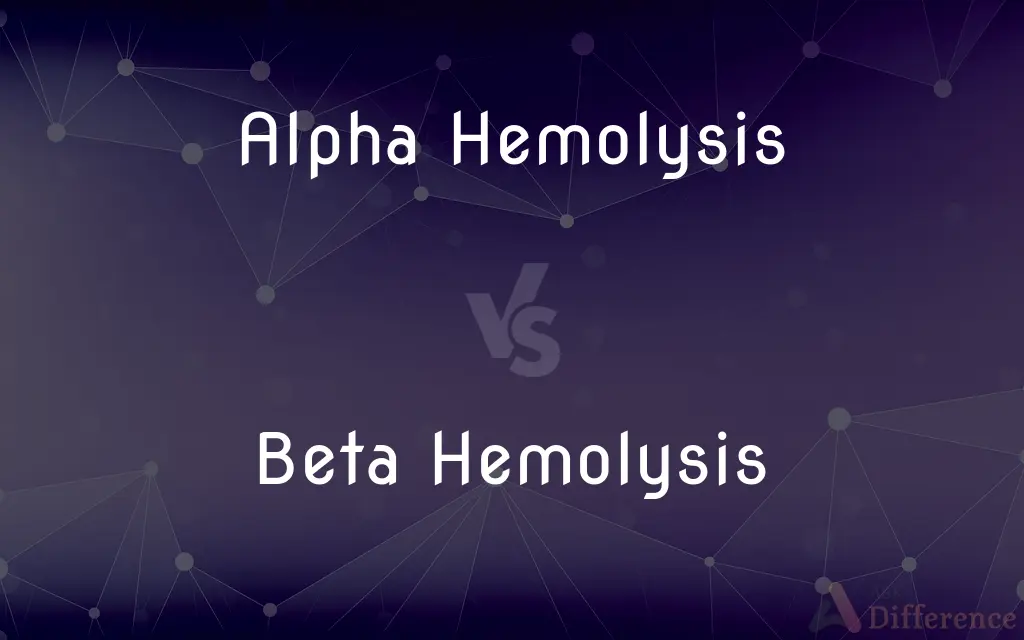Alpha Hemolysis vs. Beta Hemolysis — What's the Difference?
By Tayyaba Rehman — Published on January 6, 2024
Alpha hemolysis partially breaks down red blood cells, causing a greenish discoloration, while beta hemolysis completely lyses them, leaving a clear zone.

Difference Between Alpha Hemolysis and Beta Hemolysis
Table of Contents
ADVERTISEMENT
Key Differences
Alpha hemolysis is a partial hemolysis that occurs when bacteria produce hydrogen peroxide, which oxidizes hemoglobin to methemoglobin, resulting in a greenish or brownish discoloration of the agar around the bacterial colonies. This type of hemolysis is characteristic of certain streptococci and is considered less aggressive than beta hemolysis.
Beta hemolysis is the complete lysis of red blood cells and hemoglobin, leading to a clear zone surrounding the bacterial colony on the agar plate. This occurs when the bacteria secrete hemolysins that completely destroy the red blood cells. Beta-hemolytic bacteria include Staphylococcus aureus and some strains of Streptococcus pyogenes, and this type of hemolysis is associated with more pathogenic bacteria.
Alpha hemolysis represents a partial breakdown of red blood cells and is often referred to as “green hemolysis” due to the color change in the agar. It indicates the production of hydrogen peroxide and is a key identifier in differentiating bacterial species in culture.
Beta hemolysis showcases a clear and complete destruction of red blood cells around a bacterial colony. This clear zone indicates the presence of strong hemolysins that can lyse red blood cells entirely, which is important in the identification and assessment of the pathogenic potential of bacterial species.
In alpha hemolysis, the discoloration of the agar is due to the reduction of red blood cells, not their complete destruction. This can be important when determining the pathogenicity or antibiotic treatment, as alpha-hemolytic bacteria may have different sensitivity profiles compared to beta-hemolytic bacteria.
ADVERTISEMENT
Beta hemolysis indicates an organism's ability to completely lyse blood cells, which can be linked to the severity of the diseases they may cause. This characteristic is often used to diagnose and determine treatment for infections caused by beta-hemolytic organisms.
Comparison Chart
Type of Hemolysis
Partial breakdown of red blood cells
Complete lysis of red blood cells
Result on Blood Agar
Greenish or brownish discoloration
Clear, transparent zone around colonies
Hemoglobin Change
Hemoglobin is oxidized to methemoglobin
Hemoglobin is completely broken down
Pathogenicity
Less aggressive bacteria
Typically more aggressive bacteria
Associated Bacteria
Streptococcus pneumoniae, Streptococcus viridans
Staphylococcus aureus, Streptococcus pyogenes
Compare with Definitions
Alpha Hemolysis
A bacterial reaction that partially oxidizes red blood cells, producing a green tint.
Streptococcus pneumoniae shows alpha hemolysis on blood agar.
Beta Hemolysis
A clear, transparent zone around a colony due to hemoglobin lysis.
The clear halo around the bacteria signifies beta hemolysis.
Alpha Hemolysis
Alpha hemolysis is a form of blood cell breakdown causing a brown discoloration.
Upon culturing, a green-brown discoloration shows alpha hemolysis.
Beta Hemolysis
Lysis that leaves blood agar clear from the complete breakdown of red blood cells.
The presence of beta hemolysis can aid in diagnosing bacterial infections.
Alpha Hemolysis
A type of hemolysis indicative of non-aggressive bacterial activity.
Alpha hemolysis suggests a less virulent strain of Streptococcus.
Beta Hemolysis
Complete destruction of red blood cells by bacterial enzymes, resulting in a clear zone.
Staphylococcus aureus typically exhibits beta hemolysis.
Alpha Hemolysis
The process where hemoglobin is reduced to methemoglobin around a colony.
Alpha hemolysis is characterized by a greenish halo on the culture plate.
Beta Hemolysis
Beta hemolysis shows full disintegration of red cells in the vicinity of a bacterial colony.
The beta hemolysis observed dictates the potential for severe infection.
Alpha Hemolysis
The incomplete lysis of hemoglobin, leaving a greenish color on agar media.
The alpha hemolysis indicates partial oxidation by the bacteria.
Beta Hemolysis
Represents a strong hemolytic activity by pathogenic bacteria.
Beta hemolysis on the agar plate indicates a highly virulent organism.
Common Curiosities
What does beta hemolysis look like on a blood agar plate?
It's seen as a clear, transparent zone surrounding the bacterial colony.
Which organisms are commonly associated with alpha hemolysis?
Streptococcus pneumoniae and Streptococcus viridans are commonly alpha-hemolytic.
Are beta-hemolytic bacteria typically more virulent?
Yes, beta-hemolytic bacteria are often more pathogenic.
Does beta hemolysis always signify a severe infection?
Not always, but it often indicates a bacterium with potential for severe disease.
Can the same bacterium exhibit both alpha and beta hemolysis?
Some bacteria can exhibit both, depending on the conditions or strain.
What does the clear zone in beta hemolysis indicate?
It indicates complete destruction of red blood cells.
What does alpha hemolysis look like on a blood agar plate?
It appears as a greenish or brownish discoloration around the bacterial colony.
Are there any treatments specifically for beta-hemolytic infections?
Treatment usually includes antibiotics, guided by the specific bacteria causing the infection.
What is the significance of green coloration in alpha hemolysis?
It signifies partial hemolysis and oxidation of hemoglobin to methemoglobin.
Can alpha hemolysis cause disease?
While less aggressive, alpha-hemolytic bacteria can still cause infections.
Is alpha hemolysis harmful to human health?
It can be, depending on the bacterial strain and host factors.
Can hemolysis patterns change over time?
Yes, the hemolysis pattern may change as the bacterial colony grows and ages.
How can you differentiate between alpha and beta hemolysis?
Alpha hemolysis shows a greenish discoloration, while beta shows a clear zone on blood agar.
How do medical professionals use hemolysis information?
They use it to identify bacteria and to help determine potential treatment options.
Is there a gamma hemolysis?
Yes, gamma hemolysis refers to no hemolysis or change in the blood agar.
Share Your Discovery

Previous Comparison
Autocad vs. Inventor
Next Comparison
Data Analytics vs. Predictive AnalyticsAuthor Spotlight
Written by
Tayyaba RehmanTayyaba Rehman is a distinguished writer, currently serving as a primary contributor to askdifference.com. As a researcher in semantics and etymology, Tayyaba's passion for the complexity of languages and their distinctions has found a perfect home on the platform. Tayyaba delves into the intricacies of language, distinguishing between commonly confused words and phrases, thereby providing clarity for readers worldwide.












































